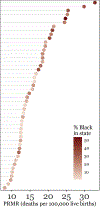Changing the conversation: applying a health equity framework to maternal mortality reviews
- PMID: 31499056
- PMCID: PMC11003448
- DOI: 10.1016/j.ajog.2019.08.057
Changing the conversation: applying a health equity framework to maternal mortality reviews
Abstract
The risk of maternal death in the United States is higher than peer nations and is rising and varies dramatically by the race and place of residence of the woman. Critical efforts to reduce maternal mortality include patient risk stratification and system-level quality improvement efforts targeting specific aspects of clinical care. These efforts are important for addressing the causes of an individual's risk, but research to date suggests that individual risk factors alone do not adequately explain between-group disparities in pregnancy-related death by race, ethnicity, or geography. The holistic review and multidisciplinary makeup of maternal mortality review committees make them well positioned to fill knowledge gaps about the drivers of racial and geographic inequity in maternal death. However, committees may lack the conceptual framework, contextual data, and evidence base needed to identify community-based contributing factors to death and, when appropriate, to make recommendations for future action. By incorporating a multileveled, theory-grounded framework for causes of health inequity, along with indicators of the community vital signs, the social and community context in which women live, work, and seek health care, maternal mortality review committees may identify novel underlying factors at the community level that enhance understanding of racial and geographic inequity in maternal mortality. By considering evidence-informed community and regional resources and policies for addressing these factors, novel prevention recommendations, including recommendations that extend outside the realm of the formal health care system, may emerge.
Keywords: maternal death; maternal mortality; maternal mortality review committees; quality improvement.
Copyright © 2019 Elsevier Inc. All rights reserved.
Conflict of interest statement
The authors report no conflict of interest.
Figures



Similar articles
-
Postpartum hemorrhage outcomes and race.Am J Obstet Gynecol. 2018 Aug;219(2):185.e1-185.e10. doi: 10.1016/j.ajog.2018.04.052. Epub 2018 May 9. Am J Obstet Gynecol. 2018. PMID: 29752934
-
Racial and Ethnic Disparities in Pregnancy-Related Mortality in Illinois, 2002-2015.J Womens Health (Larchmt). 2019 Aug;28(8):1153-1160. doi: 10.1089/jwh.2018.7557. J Womens Health (Larchmt). 2019. PMID: 31408426
-
Racial and Ethnic Disparities in Maternal Mortality in the United States Using Enhanced Vital Records, 2016‒2017.Am J Public Health. 2021 Sep;111(9):1673-1681. doi: 10.2105/AJPH.2021.306375. Epub 2021 Aug 12. Am J Public Health. 2021. PMID: 34383557 Free PMC article.
-
Epidemiology of maternal morbidity and mortality.Semin Perinatol. 2017 Oct;41(6):332-337. doi: 10.1053/j.semperi.2017.07.007. Epub 2017 Aug 18. Semin Perinatol. 2017. PMID: 28823579 Review.
-
Improving hospital quality to reduce disparities in severe maternal morbidity and mortality.Semin Perinatol. 2017 Aug;41(5):266-272. doi: 10.1053/j.semperi.2017.04.002. Epub 2017 Jul 21. Semin Perinatol. 2017. PMID: 28735811 Free PMC article. Review.
Cited by
-
Understanding the role of childhood nurture, abuse, and stability on gestational diabetes in the Coronary Artery Risk Development in Young Adults study (CARDIA).Ann Epidemiol. 2024 Mar;91:30-36. doi: 10.1016/j.annepidem.2024.01.007. Epub 2024 Jan 23. Ann Epidemiol. 2024. PMID: 38266664 Free PMC article.
-
Urban-rural differences in pregnancy-related deaths, United States, 2011-2016.Am J Obstet Gynecol. 2021 Aug;225(2):183.e1-183.e16. doi: 10.1016/j.ajog.2021.02.028. Epub 2021 Feb 25. Am J Obstet Gynecol. 2021. PMID: 33640361 Free PMC article.
-
Zooming in and out: a holistic framework for research on maternal, late foetal and newborn survival and health.Health Policy Plan. 2022 May 12;37(5):565-574. doi: 10.1093/heapol/czab148. Health Policy Plan. 2022. PMID: 34888635 Free PMC article. Review.
-
Pregnancy outcomes in women with sickle cell disease in California.Am J Hematol. 2023 Mar;98(3):440-448. doi: 10.1002/ajh.26818. Epub 2023 Jan 4. Am J Hematol. 2023. PMID: 36594168 Free PMC article.
-
Severe Maternal Morbidity and Maternal Mortality in Women With Intellectual and Developmental Disabilities.Am J Prev Med. 2021 Dec;61(6):872-881. doi: 10.1016/j.amepre.2021.05.041. Epub 2021 Sep 25. Am J Prev Med. 2021. PMID: 34579985 Free PMC article.
References
-
- Division of Reproductive Health. Pregnancy Mortality Surveillance System [Internet]. National Center for Chronic Disease Prevention and Health Promotion, Centers for Disease Control and Prevention. 2017. Available at: https://www.cdc.gov/reproductivehealth/maternalinfanthealth/pmss.html. Accessed January 1, 2017.
Publication types
MeSH terms
Grants and funding
LinkOut - more resources
Full Text Sources

